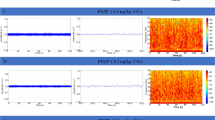Abstract
The nature of the tolerance that develops to the sedative action of lorazepam was investigated using a holeboard apparatus. Rats treated with lorazepam (0.125, 0.25 and 0.50 mg/kg) once daily for 3 days showed similar degrees of tolerance to the effects of a test dose of 0.25 mg/kg lorazepam. Tolerance was also observed in animals treated once every 2 days with lorazepam (0.50 mg/kg). Measurement of the plasma and brain concentrations of lorazepam immediately after the behavioural test showed that this tolerance was functional and not dispositional. In contrast, the behavioural effects of lorazepam were not reduced as a result of 3 days of treatment with a sedative dose of sodium pentobarbitone (20 mg/kg), although this led to lower brain concentrations of lorazepam at the time of testing.
Similar content being viewed by others
References
Bowery NE (ed) (1983) Actions and interactions of GABA and benzodiazepines. Raven Press, New York
Crawley JN, Marangos PJ, Stivers J, Goodwin FK (1982) Chronic clonazepam administration induces benzodiazepine receptor subsensitivity. Neuropharmacology 21:85–89
Davies CL, Nutt DJ (1983) Repeated electroconvulsive shock alters diazepam pharmacokinetics in rats. Br J Pharmacol 78:114P
Dencker Christensen J (1973) Tolerance development with chlordiazepoxide in relation to the plasma levels of the parent compound and its main metabolites in mice. Acta Pharmacol Toxicol 33:262–272
Ellinwood EH, Linnoila M, Easler ME, Molter DW (1983) Profile of acute tolerance to three sedative anxiolytics. Psychopharmacology 79:137–141
File SE (1981) Rapid development of tolerance to the sedative effects of lorazepam and triazolam in rats. Psychopharmacology 73:240–245
File SE (1982a) Recovery from lorazepam tolerance and the effects of a benzodiazepine antagonist (RO 15-1788) on the development of tolerance. Psychopharmacology 77:284–288
File SE (1982b) Development and retention of tolerance to the sedative effects of chlordiazepoxide: role of apparatus cues. Eur J Pharmacol 81:637–643
File SE, Wardill AG (1975) Validity of head-dipping as a measure of exploration in a modified holeboard. Psychopharmacology 44:53–59
Gallager DW, Van der Maalen C, Lakoski J (1982) Paper presented to the American college of neuropsychology, Puerto Rico, December 1982
Greenblatt DJ, Franke K, Shader RI (1978) Analysis of lorazepam and its glucoronide metabolite by electron-capture gas liquid chromatography. J Chromatogr 146:311–320
Hoogland DR, Miya TS, Bousquet WF (1966) Metabolism and tolerance studies with chlordiazepoxide-2-14C in the rat. Toxicol Appl Pharmacol 9:116–123
Kalant H, LeBlanc AE, Gibbins RJ (1971) Tolerance to, and dependence on, some non-opiate psychotropic drugs. Pharmacol Rev 23:135–191
Lister RG, File SE, Greenblatt DJ (1983a) The behavioral effects of lorazepam are poorly related to its concentration in the brain. Life Sci 32:2033–2040
Lister RG, Abernethy DR, Greenblatt DJ, File SE (1983b) Methods for the determination of lorazepam and chlordiazepoxide and metabolites in brain tissue: a comparison with plasma concentrations in the rat. J Chromatogr 277:201–208
Margules DL, Stein L (1968) Increase of ‘antianxiety’ activity and tolerance of behavioral depression during chronic administration of oxazepam. Psychopharmacology 13:74–80
Preskorn SH, Irwin GH, Simpson S, Friesen D, Rinne J, Jerkovich G (1981) Medical therapies for mood disorders alter the blood-brain barrier. Science 213:469–471
Rosenberg HC, Chiu TH (1981) Tolerance during chronic benzodiazepine treatment associated with decreased receptor binding. Eur J Pharmacol 70:453–460
Rosenberg HC, Smith S, Chiu TH (1983) Benzodiazepine-specific and nonspecific tolerance following chronic flurazepam treatment. Life Sci 32:279–285
Schillings RT, Sisenwine SF, Ruelius HW (1977) Disposition and metabolism of lorazepam in the male rat. Drug Metab Dispos 5: 425–435
Author information
Authors and Affiliations
Rights and permissions
About this article
Cite this article
Lister, R.G., File, S.E. & Greenblatt, D.J. Functional tolerance to lorazepam in the rat. Psychopharmacology 81, 292–294 (1983). https://doi.org/10.1007/BF00427565
Received:
Accepted:
Issue Date:
DOI: https://doi.org/10.1007/BF00427565



